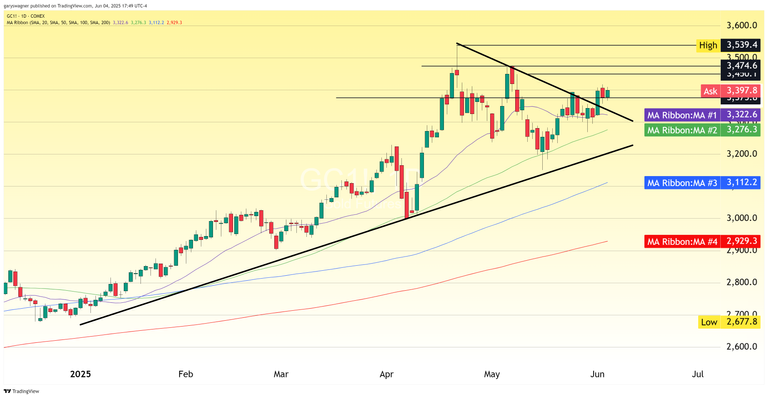Gold futures surged Wednesday, with the most active August contract (GCQ2025) climbing $19.50, or 0.58%, as of 4:35 ET, driven primarily by U.S. dollar weakness following disappointing economic indicators that have reignited speculation about potential Federal Reserve policy easing.

The rally occurred against a backdrop of limited geopolitical developments, with no fresh updates on trade negotiations or the ongoing conflicts in Europe. Instead, gold's advance was almost entirely attributed to the greenback's decline, with the U.S. Dollar Index (DXY) falling 0.43% during the session.
The dollar's weakness stemmed from a series of economic reports that painted a concerning picture of the U.S. economy's momentum. The services sector contracted in May for the first time in nearly a year, according to the latest ISM Services PMI, as new business orders declined sharply while input costs surged amid pressure from recently implemented tariffs.
Compounding these concerns, private sector job creation decelerated significantly, with ADP reporting that employers added only 37,000 positions in May—the weakest monthly gain since March 2023 and substantially below consensus expectations of 115,000 new hires. This sharp slowdown in private employment growth signals potential softening in labor market conditions as the economy heads into the second half of the year.
The deteriorating labor market data has fueled hopes for earlier Federal Reserve action, as lower interest rates typically weaken the dollar by reducing the appeal of U.S. Treasury securities to yield-seeking investors. According to the CME's FedWatch tool, the probability of a rate cut this month doubled to 4.4%, though most market participants continue to anticipate the first reduction at the September FOMC meeting.
The employment trend appears to be following a multi-year downward trajectory. Historical data shows a steady decline in job creation, from 241,000 new positions in May 2022 to 227,000 in May 2023 and 193,000 last May. Current forecasts for Friday's official nonfarm payrolls report suggest a further deceleration to 170,000 new jobs, which would continue this concerning pattern.
Adding another layer of complexity to the monetary policy landscape, former President Trump has renewed his criticism of Federal Reserve Chair Jerome Powell through social media posts calling for immediate rate cuts. However, these public interventions may prove counterproductive, as Powell has historically demonstrated reluctance to appear influenced by political pressure, potentially strengthening his resolve to maintain the current policy stance.
Market Focus Shifts to Friday
Friday's nonfarm payrolls report has emerged as a critical data point that could reshape monetary policy expectations and gold's trajectory. A meaningful decline in job creation coupled with rising unemployment could accelerate the timeline for Fed easing, providing additional support for non-yielding assets like gold while further pressuring the dollar.
For precious metals investors, the current environment presents a confluence of supportive factors: weakening economic fundamentals, dollar depreciation, and growing anticipation of looser monetary policy. However, the sustainability of gold's rally will largely depend on whether upcoming economic data confirms the emerging narrative of economic deceleration or provides evidence of underlying resilience in the labor market.
For those who wish to learn more about our service, please go to the links below:
Information, Track Record, Trading system, Testimonials, Free trial
Wishing you as always good trading,

